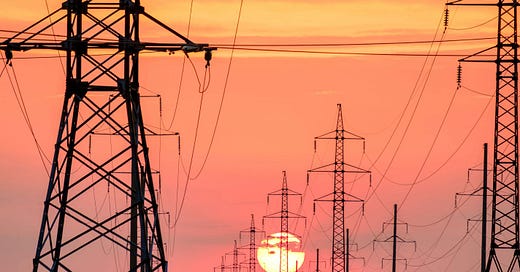FERC transmission order "gift" to solar and wind
Transmission providers have to look ahead 20+ years, socialize costs of renewables mandates
The Federal Energy Regulatory Commission (FERC) issued a “watershed transmission planning” order [this month] that would force the costs of state renewable energy mandates onto consumers in other states. While couched in language about grid reliability and affordability, the rule will instead push utilities further toward intermittent and unreliable wind and solar.
FERC is an independent federal agency that regulates sales of electricity between power suppliers and utilities, as well as interstate electricity transmission. For wind turbines and solar panels to get electricity to consumers, they must be connected to the grid. However, since wind and solar projects are usually located in remote areas with large land areas, heavy-duty transmission lines are needed to move that electricity to urban areas. Hence the drumbeat for more transmission capabilities, sometimes in the face of opposition from environmental groups and locals.
The rule requires transmission operators to develop regional transmission plans that look ahead at least 20 years. Operators must assume that federal, state, or local laws mandating resource mix, decarbonization, and electrification will be met. That means that transmission providers must assume that the expensive, unworkable net-zero public policies put forth in states will happen as written.
FERC simultaneously passed Order 1977, which “gives it the authority to grant permits to electric transmission lines in certain instances where states do not act first.” This is a departure from current practice, where states have authority over transmission and siting permits.
How projects are paid for gets tricky, but stick with me. Order 1920 lumps together policy-driven transmission projects (read: projects driven by clean energy mandates) with transmission needed for economic or reliability reasons. The final rule requires providers to file ex ante (“before the event”) default cost allocation methods that apply to all kinds of projects — even if specific states within a region did not agree to bear the costs of mandates in other states. Of course, providers are to “consult with and seek support” from states, but are not required to do anything with that input. In the proposed rule, FERC would’ve allowed states to voluntarily agree to different distributions of costs.
In a dissenting statement on the final rule, FERC Commissioner Mark Christie, the lone Republican on FERC’s three-member board, wrote:
, Director of Energy and Environmental Studies at the Cato Institute, explains some of the challenges of the rule:But that’s not all; here comes the worst part of the shell game. The final rule then requires every transmission provider in America to file an ex ante cost allocation formula that is applicable to the whole bucket of projects, which now includes public and corporate-driven policy projects, in order to socialize the costs of these projects across the entire region, even when states in a region have never consented for their consumers to bear the costs of such projects.
Despite some sugarcoating from FERC, this plan: (1) mandates that regional transmission plans socialize the cost of the most aggressive climate and renewable energy goals of some states and corporate customers at the expense of consumers and taxpayers everywhere, (2) derives from no clear authority granted by Congress, and (3) was rushed to avoid further scrutiny under the Congressional Review Act.
It is likely the final rule will be challenged under the major questions doctrine, which requires clear Congressional approval for questions of “vast economic and political significance.”
FERC would be blind if it didn’t realize its transmission regulations will increase costs to consumers who must now bear the brunt of other states’ emissions mandates. Let’s hope this rule gets the scrutiny it deserves.
This piece was originally published at Independent Women’s Forum on May 23, 2024. Read more here: https://www.iwf.org/2024/05/23/ferc-transmission-order-gift-to-solar-and-wind/




In other words another subsidy via more Federal control and power. It appears at every turn the solutions to the issues-created by them in the first place-is more Federal power-central-instead of state people-the people. When will we learn?
FERC needs a return to its more balanced, light-handed management style.